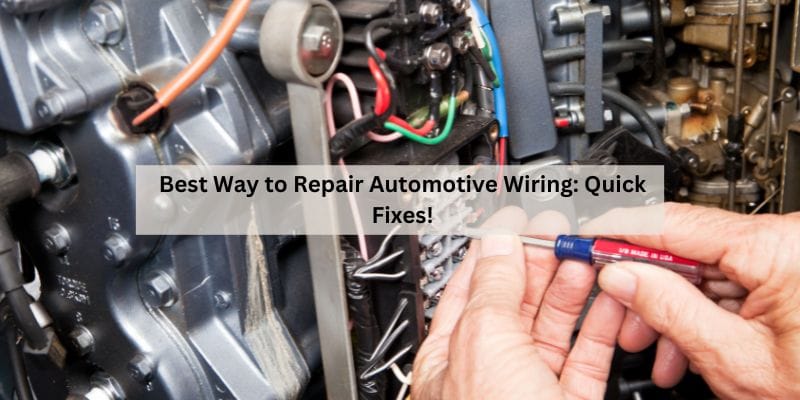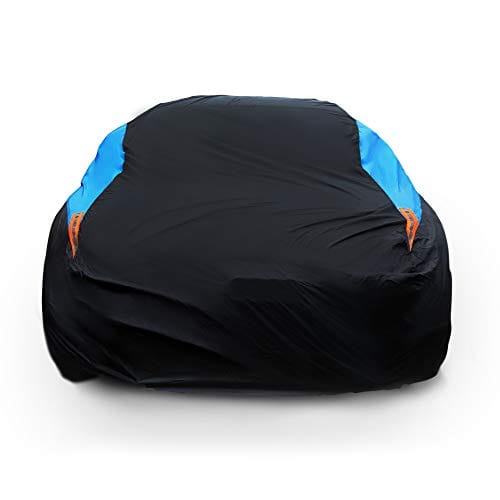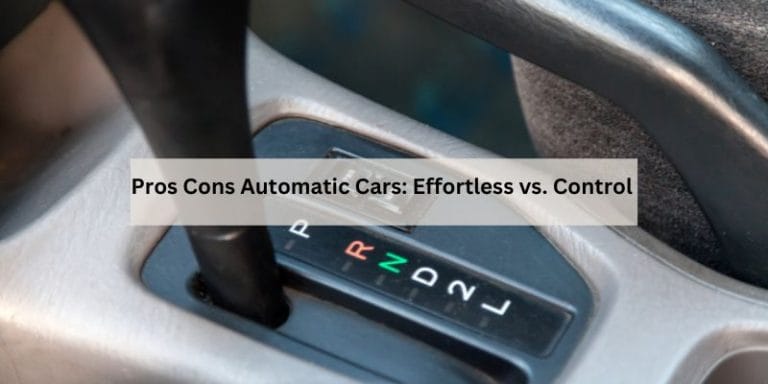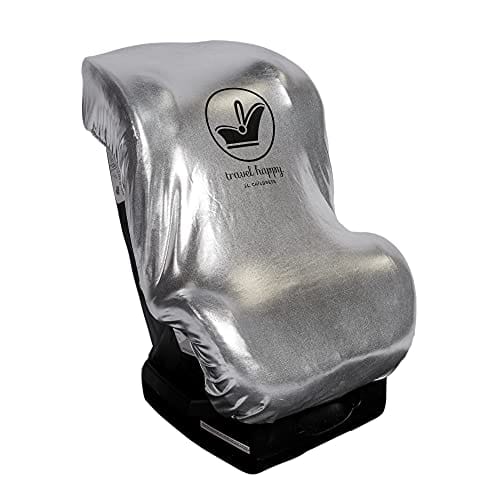Best Way to Repair Automotive Wiring: Quick Fixes!
The best way to repair automotive wiring is by cutting the wire, sliding heat shrink tubing over it, splicing the wire back together, and applying heat to seal the shrink tubing. This method provides a secure and long-lasting fix compared to simply wrapping electrical tape around the damaged area.
Rosin-core solder should be used for electrical repairs, and heat should be applied using a soldering iron kit. Crimping a butt-splice connector between the broken wire pieces is another efficient option, preserving the wire length and eliminating the need for soldering.
It’s important to ensure a proper connection to maintain the integrity of the automotive wiring system.
Introduction To Automotive Wiring Repair
Proper wiring maintenance is crucial to ensure the safety and reliability of your vehicle. Common issues with automotive wiring include fraying, corrosion, and exposure to elements. When repairing automotive wiring, it’s essential to use the right tools and techniques. Soldering is a popular method for repairing broken wires, and using heat shrink tubing provides added protection. When it comes to soldering, it’s important to use rosin-core solder for electrical repairs. If you’re looking to fix a broken wire without soldering, alternative methods such as twisting and insulating the wires can be used. Additionally, when dealing with a damaged wire harness, it’s important to know the proper steps for repair. By following the correct procedures, you can ensure the longevity and performance of your vehicle’s electrical system.
Essential Tools For Wiring Repair
When repairing automotive wiring, it’s essential to have the basic tools for any DIYer. These include wire strippers, crimping tools, and butt connectors. For advanced repairs, specialized tools such as quick splices, dielectric grease, and liquid tape are crucial. Properly repairing automotive wiring involves striping insulation, crimping connectors, and applying heat to shrink insulation. Only use rosin-core solder for electrical repairs and avoid just wrapping electrical tape around the wires. For safely repairing or replacing worn out electrical wires, slip heat shrink tubing over the spliced wire and apply heat to seal the tubing. Always ensure that the repair is secure and well-protected to prevent further damage. By following these guidelines and using the right tools, anyone can effectively repair automotive wiring.
Preparation Steps For Successful Repairs
Preparation is key for successful automotive wiring repairs. When it comes to safety first, always take necessary precautions. Identify the damage and assess the repair scope to understand the extent of the issue. When it comes to repairing automotive wiring, it is crucial to use the right tools and techniques. Use rosin-core solder for electrical repairs and apply heat to the wire using the tip of the soldering iron kit. Properly splice the wire back together and apply heat shrink tubing to seal the repair. Avoid using just electrical tape as it may not provide a long-term solution. By following these steps, you can effectively repair automotive wiring and ensure the safety and functionality of the vehicle.
Quick Fixes For Minor Wiring Issues
Discover the best way to repair automotive wiring with quick fixes for minor wiring issues. Learn how to solder and protect wires, use heat shrink tubing, and apply dielectric grease for a reliable repair. Avoid the hassle of electrical tape and ensure a safe and durable fix for your automotive wiring.
There are various ways to quickly fix minor automotive wiring issues without the need for professional help. One temporary solution is to use electrical tape to cover exposed wires and prevent them from touching each other. However, for a more permanent fix, butt connectors can be used to splice wires together. Butt connectors are small tubes with metal connectors inside that can be crimped onto the wires to create a secure connection. They come in various sizes to fit different wire gauges. It is important to strip the insulation off the wires before crimping the connectors. Other quick fixes include using Scotch locks and quick splices. It is also recommended to apply dielectric grease or liquid tape to protect the wires from moisture and corrosion.
Comprehensive Guide To Soldering Automotive Wires
Discover the best way to repair automotive wiring with our comprehensive guide to soldering automotive wires. Learn how to splice and solder wires, apply heat to close shrink tubing, and protect your electrical connections for a reliable fix. Say goodbye to frayed wires and ensure the safety and functionality of your car’s electrical system.
Automotive wiring can be a tricky task, but with the right tools and techniques, it can be done with ease. Before soldering, it is important to properly prepare the wires. This includes stripping the insulation, twisting the wires together, and crimping butt connectors. Once the wires are prepared, the soldering process can begin. It is important to use rosin-core solder and apply heat to the wire using the tip of the soldering iron kit. After soldering, the heat-shrink tubing should be placed over the joint and heated to create a seal. Other methods of repairing automotive wiring include using scotch locks and quick splice connectors, but soldering provides a stronger and more reliable connection. With these steps, repairing automotive wiring can be a simple and effective process.
Using Crimping For Durable Wire Connections
|
When it comes to repairing automotive wiring, using crimping for durable wire connections is a great option. However, it is important to choose the right crimping tools for the job. For instance, butt connectors are a popular choice for crimping wires together, but it is important to select the right size for the wires being connected. Moreover, if the wires are exposed to moisture or other elements, it is essential to use dielectric grease or liquid tape to protect the connection. On the other hand, soldering is another option for repairing automotive wiring. It is crucial to use the right kind of solder, such as rosin-core solder, and a soldering iron kit for electrical repairs. When deciding between crimping and soldering, it is important to consider the specific situation. Crimping is typically faster and easier for simple repairs, while soldering may be necessary for more complex or delicate wiring. |
Protecting And Insulating Repaired Wires
Protecting and insulating repaired wires is crucial when it comes to the best way to repair automotive wiring. By using techniques such as soldering, heat shrink tubing, and applying dielectric grease or liquid tape, you can ensure the longevity and reliability of your repaired wires, safeguarding your vehicle’s electrical system.
Repairing automotive wiring can be a tricky task, but with the right tools and techniques, it can be done easily. One way to protect and insulate repaired wires is by applying heat shrink tubing. This tubing shrinks when heat is applied, creating a tight seal around the wire. Another effective method is using liquid electrical tape, which creates a protective coating around the wire to prevent any further damage. When repairing automotive wiring, it’s important to use the right tools, such as butt connectors, scotch locks, and quick splice connectors. Rosin-core solder should be used for electrical repairs, and dielectric grease can be applied to protect the connections. By following these tips and techniques, you can repair and protect automotive wiring with confidence.
Advanced Repair Techniques
Repairing a wiring harness can be a complex task, but with the right techniques, it can be done effectively. One of the best ways to repair automotive wiring is by using advanced methods such as soldering and protecting the wires. When dealing with complex wiring issues, it is essential to use the right tools and materials. Butt connectors, scotch locks, quick splice, dielectric grease, and liquid tape are some of the essential items for repairing automotive wiring. Additionally, using heat shrink tubing and rosin-core solder can provide a secure and long-lasting repair. It’s important to ensure that the wires are spliced and soldered correctly to maintain the integrity of the electrical connections. By following these advanced repair techniques, automotive wiring can be effectively repaired and protected for reliable performance.
Maintenance Tips To Prevent Future Wiring Problems
The best way to repair automotive wiring involves regular inspection routines to identify any potential issues early on. It is important to follow best practices for wiring health to prevent future problems. When inspecting the wiring, ensure that there are no signs of fraying or damage. In the event of worn-out electrical wires, cutting the wire, slipping heat shrink tubing over it, splicing the wire back together, and applying heat to close the shrink tubing is the recommended method for repair. For electrical repairs, only rosin-core solder should be used, and rosin flux can be added for an additional layer of protection. It is crucial to use the right tools and techniques to safely repair or replace worn out electrical wires in automotive wiring. Following these practices will help maintain the integrity of automotive wiring and prevent potential issues in the future.
Frequently Asked Questions
Can Electrical Wiring Be Repaired?
Yes, electrical wiring can be repaired. The best way to repair frayed electrical wires is to cut the wire, slide heat shrink tubing over it, splice the wire back together, and apply heat to shrink the tubing. Alternatively, you can wrap electrical tape around it, but this is not as effective.
For automotive wiring repairs, rosin-core solder should be used.
What Kind Of Solder Is Used To Repair Automotive Electrical Wiring?
Rosin-core solder is the type of solder used to repair automotive electrical wiring. It is important to use this type of solder for electrical repairs. The wires should be coated with rosin flux before applying heat with a soldering iron kit.
This ensures a secure and reliable connection.
How To Fix A Broken Wire Without Soldering?
The quickest way to fix a broken wire without soldering is by using a butt-splice connector. Strip both ends of the wire, insert them into the connector, and crimp it to secure them together. This method is fast, doesn’t require soldering, and preserves the length of the wire.
Can A Car Wiring Harness Be Repaired?
Yes, a car wiring harness can be repaired. The best way to repair it is by cutting the wire, slipping heat shrink tubing over it, splicing the wire back together, and applying heat to close the shrink tubing. This provides a secure and long-lasting repair.
Conclusion
Repairing automotive wiring can be done effectively using various techniques such as soldering, splicing, and using heat shrink tubing. It is important to use the right tools and materials, such as rosin-core solder and butt-splice connectors, to ensure a secure and long-lasting repair.
By following proper techniques and taking necessary precautions, you can safely repair and protect your car’s wiring, ensuring optimal performance and avoiding potential electrical issues in the future.






